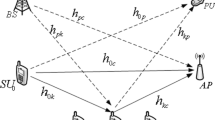Abstract
Recently, the multi-hop cellular networks have been widely studied in order to enhance the cell performances such as the cell capacity. While most of these works merely use the multi-hop methods instead of direct transmission without considering the co-channel inter-cell interference, signal transmission mode and the effects of the number of antennas. With the consideration of above important elements, this paper proposed an improved cellular system with multi-relay amplifies-and-forward (AF) cooperative transmission scheme and the corresponding capacity expression is derived under the corresponding environment. By using the potential space diversity and selecting relays based on maximizing the capacity, the cellular system capacity can be improved effectively. The simulation results show that with the assistance of optimal selected relays, the improved cooperative cellular system capacity with multi-relay AF transmission scheme performs better than single-hop cellular system.
Similar content being viewed by others
References
Jacobson K R, Krzymien W A. Cell dimensioning and network throughput in cellular multi-hop relay networks [C]// Proceedings of the 64th IEEE Vehicular Technology Conference, Montreal, Canada. 2006, DOI: 10.119/VTCF.2006.497.
Lee K H, Han K Y, Song J Y, Cho D H. Capacity enhancement of uplink channel through spatial reuse in multihop cellular networks [J]. IEEE Communications Letters, 2006, 10(2): 76–78.
Cho J, Haas Z J. On the throughput enhancement of the downstream channel in cellular radio networks through multihop relaying [J] IEEE Journal Selected Areas in Communications, 2004, 22(7): 1206–1219.
Wang L C, Su W S, Huang J H, Chen A, Chang C J. Optimal relay location in multi-hop cellular systems [C]// Proceedings of the Wireless Communications and Networking Conference. 2008: 1306–1310.
Hu H N, Yanikomeroglu H, Falconer D D, Periyalwar S. Range extension without capacity penalty in cellular networks with digital fixed relays [C]// Proceedings of the Global Telecommunications Conference. 2004: 3053–3057.
Murad H M F, Mammela A, Chowdhury H. Impact of mobile relays on throughput and delays in multihop cellular network [C]// Proceedings of the 4th International Conference on Wireless and Mobile Communications. 2008: 304–308.
Nourizadeh H, Nourizadeh S, Tafazolli R. Performance evaluation of cellular networks with mobile and fixed relay station [C]// Proceedings of the 64th IEEE Vehicular Technology Conference, Montreal, Canada. 2006, DOI: 10.1109/VTCF.2006.501.
Zhang Jing-mei, Wang Ying, Zhang Ping. Capacity analysis and power allocation for multi-antenna cooperative system [J]. Journal of Beijing University of Posts and Telecommunications, 2005, 28(5): 11–15 (in Chinese).
Author information
Authors and Affiliations
Corresponding author
Additional information
Project supported by the Shanghai Leading Academic Discipline Project (Grant No.S30108), the Science and Technology Commission of Shanghai Municipality (Grant No.08DZ2231100), the Shanghai Pujiang Program (Grant No.08PJ14057), and the Graduate Student Innovation Foundation of Shanghai University (Grant No.SHUCX080151)
About this article
Cite this article
Chen, Hm., Xie, Wh., Wang, L. et al. Research on the improved cooperative cellular system capacity. J. Shanghai Univ.(Engl. Ed.) 15, 85–88 (2011). https://doi.org/10.1007/s11741-011-0697-1
Received:
Revised:
Published:
Issue Date:
DOI: https://doi.org/10.1007/s11741-011-0697-1




